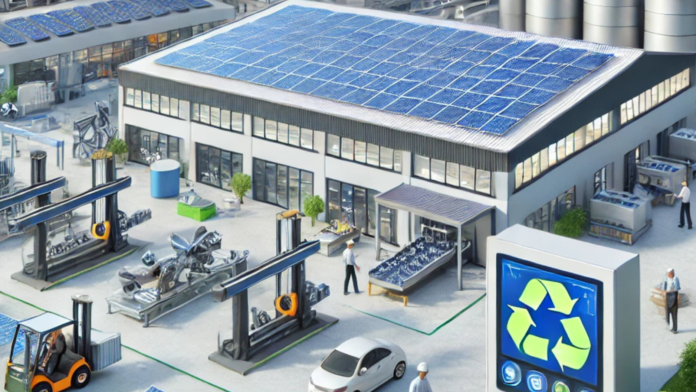In today’s global economy, supply chains play a crucial role in determining the efficiency, profitability, and sustainability of businesses. With increasing awareness of climate change, environmental impact, and resource scarcity, companies are now reevaluating their supply chains to align with green initiatives. Green supply chains, focused on minimizing environmental impacts while maintaining efficiency, are becoming the new standard in logistics. This article explores how green supply chains are redefining logistics and the best practices companies can adopt to drive sustainability.
The Shift Toward Green Supply Chains
Supply chains have traditionally been linear, with goods flowing from production to consumers, with little regard for environmental impact. However, the environmental costs associated with logistics—such as carbon emissions from transportation, waste from packaging, and resource-intensive production methods—are significant contributors to global environmental degradation. Green supply chains, on the other hand, aim to reduce these environmental impacts while optimizing operations and costs.
Sustainability in supply chains now extends beyond just compliance with regulations; it is a strategic priority for businesses that seek to innovate, improve operational efficiency, and enhance their brand reputation.
Key Components of Green Supply Chains
1. Sustainable Sourcing
Green supply chains begin with sustainable sourcing of raw materials. Businesses must ensure that the materials used in production are responsibly sourced, whether from renewable resources or from suppliers that adhere to ethical and environmental standards. This involves working with suppliers who reduce their carbon footprint, minimize waste, and utilize eco-friendly materials. Certifications such as Fair Trade, Rainforest Alliance, or FSC (Forest Stewardship Council) help verify that sourcing meets sustainable standards.
2. Energy-Efficient Transportation
Transportation is one of the biggest contributors to the carbon footprint in logistics. To mitigate this, companies are shifting to energy-efficient transportation options. This includes optimizing routes using AI and GPS technology to reduce fuel consumption, investing in electric or hybrid vehicles, and using alternative fuels such as biodiesel or hydrogen.
Additionally, the concept of “last-mile delivery” is being redefined to reduce emissions. Urban consolidation centers, for example, help reduce the number of delivery vehicles in cities by consolidating loads and using greener vehicles like electric trucks or even bicycles for last-mile deliveries.
3. Eco-Friendly Packaging
Packaging plays a significant role in logistics, and it often creates a large amount of waste. Green supply chains focus on reducing packaging waste by utilizing eco-friendly materials, such as recycled paper or biodegradable plastics. Companies are also embracing the practice of “right-sizing” packaging to minimize material use and reduce the volume of space in shipping containers, thereby lowering fuel consumption during transport.
4. Circular Supply Chain Models
Circular economy principles are gaining traction in supply chain management. This involves designing products with their end-of-life in mind, encouraging reuse, remanufacturing, and recycling. For instance, companies are developing take-back programs that allow customers to return products once they’ve reached the end of their lifecycle. These products can then be refurbished or recycled to create new goods, keeping materials in use longer and reducing waste.
Circular supply chains not only reduce the demand for raw materials but also minimize waste, encouraging a more resource-efficient system.
5. Green Warehousing
Warehousing operations consume significant amounts of energy, from lighting to temperature control. Green warehouses are designed to reduce energy consumption through the use of energy-efficient lighting (e.g., LED), renewable energy sources (e.g., solar panels), and smart building systems that automate temperature and lighting control. Moreover, the layout of green warehouses is optimized to maximize space efficiency and reduce energy costs associated with moving goods.
6. Sustainable Supplier Relationships
A green supply chain requires collaboration across the entire supply chain network, including suppliers, logistics providers, and retailers. Businesses need to work closely with their partners to ensure that environmental considerations are incorporated at every stage of the supply chain. This means establishing clear sustainability criteria for suppliers, incentivizing eco-friendly practices, and fostering a culture of continuous improvement in sustainability efforts.
7. Data-Driven Decision Making
Technology plays a crucial role in enhancing the sustainability of supply chains. With advanced data analytics, companies can track and measure the environmental impact of their logistics operations in real-time. For example, IoT devices can monitor energy usage, vehicle emissions, and waste production throughout the supply chain. These insights enable businesses to identify inefficiencies, make informed decisions, and adjust strategies to minimize their environmental footprint.
Benefits of Green Supply Chains
1. Cost Savings
While the initial investment in green supply chain practices can be high, long-term cost savings are substantial. Energy-efficient transportation, green warehousing, and sustainable packaging reduce operating costs. Additionally, companies that embrace circular supply chain models can cut costs associated with raw material procurement and waste disposal.
2. Brand Reputation and Competitive Advantage
Consumers today are more eco-conscious than ever before. Brands that prioritize sustainability are more attractive to these consumers, leading to increased customer loyalty. A green supply chain demonstrates a company’s commitment to environmental responsibility, which can enhance brand reputation and give businesses a competitive edge in the marketplace.
3. Regulatory Compliance and Risk Mitigation
Governments around the world are implementing stricter environmental regulations, particularly regarding carbon emissions and waste management. By adopting green supply chain practices, companies can ensure they are compliant with these regulations, avoiding potential fines and penalties. Moreover, companies that reduce their reliance on non-renewable resources are better positioned to mitigate risks associated with supply chain disruptions due to resource scarcity.
4. Increased Resilience
Green supply chains are often more resilient in the face of disruptions. By diversifying sourcing strategies and incorporating circular economy principles, companies can reduce their reliance on single-use materials and fossil fuels, making their supply chains more flexible and adaptive to changing market conditions or environmental crises.
Challenges to Implementing Green Supply Chains
While the benefits of green supply chains are clear, there are also challenges. These include the high upfront costs of transitioning to more sustainable practices, the complexity of coordinating across global supply chain networks, and the need for investment in new technologies. However, businesses that are able to overcome these challenges will be better positioned for long-term success in an increasingly eco-conscious market.
Conclusion
Green supply chains represent a paradigm shift in logistics, where sustainability is no longer an option but a necessity. By integrating practices such as sustainable sourcing, energy-efficient transportation, circular economy models, and green warehousing, businesses can not only reduce their environmental impact but also drive operational efficiencies, reduce costs, and enhance brand value. As consumers, regulators, and stakeholders increasingly demand greener practices, companies that prioritize sustainable logistics will redefine the future of global supply chains.
—
This article outlines how green supply chains are transforming logistics. Would you like to delve into specific case studies or trends in green logistics for your audience?















